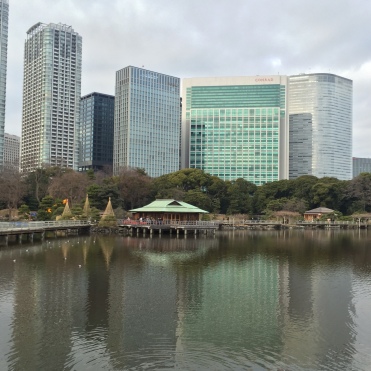There’s the vast gardens of Imperial Palace and bustle of joggers and dance groups in Meji Jingu/Yoyogi Park but Hamarikyu Gardens hold its own with its classic Japanese aesthetics and tranquility. Even on the most pleasant public holidays, Hamarikyu is sparsely populated and devoid of tourists. The garden’s placement at the foot of Shinbashi monoliths of sky scrapers (a special shout out to the noticeably ugly Dentsu building) and on the shores of Tokyo bay give it a uniquely contrasting back and fore-drop and quietly dramatic atmosphere.

Manicures gardens accentuated by stunted growth of pine trees ooze Edo period style and the two duck hunting ponds add to the charm. The main pond was designed to draw in sea water from Tokyo Bay and change appearance as the tide ebbs and flows. Lock gates open and close according to the water levels of Tokyo Bay to adjust the rise and fall of water in the pond. Salt water fish (mullets, sea bass, goby and eel) abound in the pond.
Nakajima Ocha-ya (Nakajima tea house) floating on one of the duck ponds serves up matcha paired with Japanese sweets and Matcha here is served with cappuccino-like foam. It must be the sifting and whisking… and the correct matcha to water ratio. Absolute beauty.
Hamarikyu originates from the 17th century Tokugawa Shogunate private residence. It served as the outer fort for Edo Castle with tidal pond of sea water drawn from Tokyo Bay and two duck hunting grounds. After the Meiji Restoration the garden became a Detached Palace for the Imperial family and in 1945 the Imperial family gave the garden to the City of Tokyo to be open to the public.
Y300 entrance fee, 10 minutes walk from Shinbashi St. (JR, Ginza & Asakusa Line), Open Everyday




